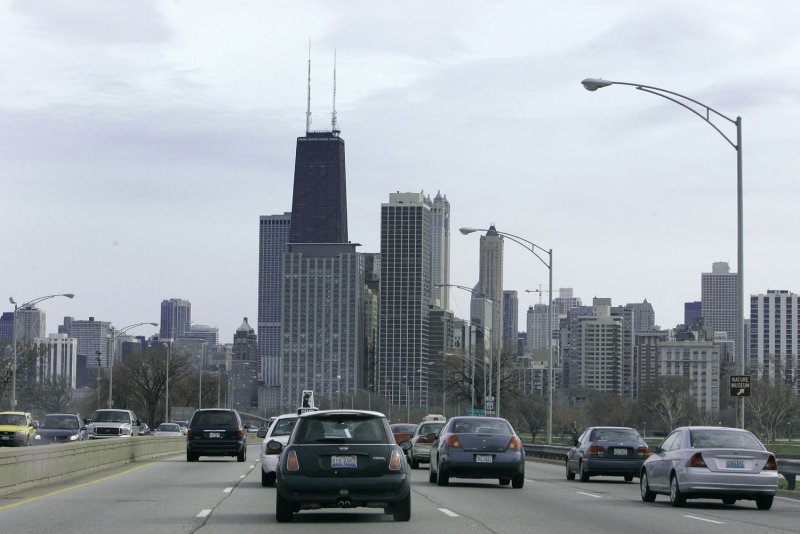WHICH HAS A GREATER IMPACT ON THE WHOLE WORLD AND NOT JUST THE USA

Despite the bad rap they have, researchers say cities are more efficient than suburbs in terms of greenhouse gas emissions. Pictured, traffic heads into downtown Chicago on Lake Shore Drive in 2007. File Photo by Brian Kersey/UPI | License Photo
July 20 (UPI) -- Wealthy homeowners contribute more to global warming than Americans in lower-income neighborhoods, according to a new survey of household energy use.
The first of its kind study -- published Monday in the journal Proceedings of the National Academy of Sciences -- looked at energy use by 93 million American homes, revealing the ways energy use drives greenhouse gas emissions in different neighborhoods and across varying parts of the country.
"One of the motivations for our study was to try to get a handle on the specifics and drivers of household energy use, which is about 20 percent of the greenhouse gas emissions in the United States," senior study author Joshua Newell told UPI.
"The more digging we did, the more we realized no one had used big data and big data analysis to understand the drivers and variables involved household energy use," said Newell, an associate professor at the University of Michigan School for Environment and Sustainability.
Newell and his research partners used a database of standardized tax assessor records to estimate building-level energy use and decipher the influence of climate, the electrical grid, household income and building attributes on a building's "greenhouse gas intensity," calculated as emissions per square meter of residential floor space.
Their statistical analysis showed a that greenhouse gas intensity is lowest in the West and highest in central areas of the United States.
The research also showed that even in places with relatively green and efficient electrical grids, affluence can have a sizable influence on greenhouse gas intensity.
"As we got deeper into our research, and as we did more detailed analysis of energy use in Los Angeles and Boston, the effects of affluence on greenhouse gas emissions began to stand out," Newell said. "You have such disparity, for example, between South Central L.A. and Beverley Hills, where you can really see the role of affluence on the size of carbon footprints."
According to Newell, it's the lack of density and the size of the houses in affluent neighborhoods that are driving disparities in greenhouse gas intensity.
Newell and his colleagues hope their findings will guide policy makers as they work to curb greenhouse gas emissions and slow climate change.
The new analysis showed that if the U.S. electrical grid is decarbonized, with fossil fuels entirely eliminated, the residential housing sector can reduce greenhouse gas emissions 28 percent by 2025, one of the targets set by the Paris Agreement.
The data showed, however, that a lot more must happen for the housing sector to meet the 80 percent emissions reduction target for 2050, researchers said.
"There is also a lot that can be done in terms of home energy retrofits and improvements to insulation and more efficient windows, which can be incentivized by policy makers and local governments," Newell said.
"One thing is that we need to encourage density wherever we can," Newell said. "Cities have gotten a bad rap during the COVID pandemic, but they are really highly efficient in terms of energy use and greenhouse gas intensity."
By highlighting the influence of affluence on greenhouse gas emissions, Newell said the research asks the question: "What responsibility do wealthier households have for combating climate change, and for paying some of the necessary energy efficiency reforms and retrofits?"
The work of Newell and his research partners at Michigan, Dimitrios Gounaridis and lead study author Benjamin Goldstein, suggests technology improvements, alone, won't be sufficient to stave off catastrophic climate change.
To stop climate change, serious lifestyle changes are likely necessary.
"I'm of the firm belief that green tech and technology can get us part of the way, but I think we all need to look in the mirror and think about our own consumption patterns," Newell said.
"That's why part of our study looked at a size of homes and emphasized the important of density, to get people to ask the question: do we really need this big of a home?"
upi.com/7023041
Scientists warn: Affluence is killing the planet

The world’s top 10 percent income earners are responsible for at least 25 percent and up to 43 percent of our environmental impact. Photo by Midnight Runner/Wiki
June 25 (UPI) -- Would you like to be rich? Chances are your answer is: "Yes! Who wouldn't want to be rich?" Clearly, in societies where money can buy almost everything, being rich is generally perceived as something good. It implies more freedom, fewer worries, more happiness, higher social status.
But here is the catch: Affluence trashes our planetary life support systems. What's more, it also obstructs the necessary transformation toward sustainability by driving power relations and consumption norms. To put it bluntly: The rich do more harm than good.
This is what we found in a new study for the journal Nature Communications. Together with co-author Lorenz Keyßer from ETH Zürich, we reviewed recent scientific literature on the links between affluence and environmental impacts, on the systemic mechanisms leading to over-consumption and on possible solutions to the problem. The article is one of a series of Scientists' Warnings to Humanity.
Technology and consumption
RELATED Superpower U.S. is on the brink of failure
The facts are clear: the wealthiest 0.54 percent, about 40 million people, are responsible for 14 percent of lifestyle-related greenhouse gas emissions, while the bottom 50 percent of income earners, almost 4 billion people, only emit around 10 percent. The world's top 10 percent income earners are responsible for at least 25 percent and up to 43 percent of our environmental impact.
Most people living in developed countries would fit into this category, meaning you don't have to consider yourself rich in order to be globally affluent. Even many poorer people in wealthy countries have a disproportionately large and unsustainable resource footprint compared to the global average.
It is less clear, however, how to address the problems that come with affluence. Progressive mainstream policymakers talk about "greening consumption" or "sustainable growth" to "decouple" affluence from climate breakdown, biodiversity loss and other planetary-scale destruction.
RELATED Study: Climate change crisis requires less growth-oriented global economy
Yet our research confirms that, in reality, there is no evidence that this decoupling is actually happening. While technological improvements have helped to reduce emissions and other environmental impacts, the worldwide growth in affluence has consistently outpaced these gains, driving all the impacts back up.
And it appears highly unlikely that this relationship will change in the future. Even the cleanest technologies have their limitations and still require specific resources to function, while efficiency savings often simply lead to more consumption.
If technology alone is not enough, it is therefore imperative to reduce the consumption of the affluent, resulting in sufficiency-oriented lifestyles: "better but less." This is all easier said than done though, for there is a problem.
RELATED Ford plans to be carbon neutral by 2050
The super affluent
The lockdown has seen a massive drop in consumption. But the resulting unprecedented dive in CO₂ and air pollutant emissions was merely incidental to the lockdown, not a deliberate part of it, and will not last.
So how can we reduce consumption as much as necessary in a socially sustainable way, while still safeguarding human needs and social security? Here it turns out the main stumbling block is not technological limits or economics itself, but the economic imperative to grow the economy, spurred by over-consumption and the political power of the super affluent
Affluent, powerful people and their governments have a vested interest in deliberately promoting high consumption and hampering sufficiency-oriented lifestyles. Since consumption decisions by individuals are strongly influenced by information and by others, this can lock in high-consumption lifestyles.
"Positional consumption" is another key mechanism, where people increasingly consume status goods once their basic needs are satisfied. This creates a growth spiral, driven by the affluent, with everyone striving to be "superior" relative to their peers while the overall consumption level rises. What appears average or normal in a developed country then rapidly becomes a top contribution at the global level.
So, how can we get out of this dilemma?
We reviewed a variety of different approaches that may have the solution. They range from reformist to radical ideas, and include post-development, de-growth, eco-feminism, eco-socialism and eco-anarchism. All these approaches have in common that they focus on positive environmental and social outcomes and not on economic growth. Interestingly, there seems to be quite some strategic overlap between them, at least in the short term. Most agree on the necessity to "prefigure" bottom-up as much as possible of the new, less affluent, economy in the old, while still demonstrating sufficiency-oriented lifestyles to be desirable.
Grass-roots initiatives such as Transition Initiatives and eco-villages can be examples of this, leading to cultural and consciousness change. Eventually, however, far-reaching policy reforms are needed, including maximum and minimum incomes, eco-taxes, collective firm ownership and more. Examples of policies that start to incorporate some of these mechanisms are the Green New Deals in the United States, United Kingdom and Europe or the New Zealand Well-being Budget 2019.
Social movements will play a crucial role in pushing for these reforms. They can challenge the notion that riches and economic growth are inherently good and bring forward "social tipping points." Ultimately, the goal is to establish economies and societies that protect the climate and ecosystems and enrich people with more well-being, health and happiness instead of more money.

Thomas Wiedmann is a professor of sustainability research at UNSW; Julia K. Steinberger is a professor in social ecology and ecological economics at the University of Leeds; and Manfred Lenzen is a professor of sustainability research in the School of Physics at the University of Sydney. This article is republished from The Conversation under a Creative Commons license. Read the original article.
Study: Climate change crisis requires less growth-oriented global economy

The pursuit of affluence is a major impediment to curbing global warming and repairing Earth's damaged ecosystems, researchers argue in a new paper. Photo by nikolabelopitov/Pixabay
June 19 (UPI) -- Economies and consumers can't aspire to both affluence and sustainability, researchers warn in a new paper, published Friday in the journal Nature Communications.
Hundreds of studies have highlighted the challenges facing the planet's climate, biodiversity and food systems -- global warming, pollution, habitat loss -- but few have focused on the relationship between Earth's climate and ecological crises and the planet's growth-oriented economies and the pursuit of affluence.
Many economists, business leaders, policy makers and even a few climate scientists have suggested technological advances will see planet Earth and its economies through the climate crisis -- continuing economic growth but with a smaller carbon footprint.
But a new paper by an international team of scientists argues such predictions ignore the realities of economic and environmental history.
The authors claim the pursuit of affluence is a major impediment to curbing global warming and repairing Earth's damaged ecosystems.
"Our paper has shown that it's actually dangerous and leads to planetary-scale destruction," Julia Steinberger, a professor of ecological economics at the University of Leeds in Britain, said in a news release. "To protect ourselves from the worsening climate crisis, we must reduce inequality and challenge the notion that riches, and those who possess them, are inherently good."
For the study, researchers looked at the drivers of consumption across the world's largest economies, as well as the role of technology in the pursuit of sustainability.
"Our paper has shown that it's actually dangerous and leads to planetary-scale destruction," Julia Steinberger, a professor of ecological economics at the University of Leeds in Britain, said in a news release. "To protect ourselves from the worsening climate crisis, we must reduce inequality and challenge the notion that riches, and those who possess them, are inherently good."
For the study, researchers looked at the drivers of consumption across the world's largest economies, as well as the role of technology in the pursuit of sustainability.
RELATED New map highlights China's export-driven CO2 emissions
"In our scientists' warning, we identify the underlying forces of overconsumption and spell out the measures that are needed to tackle the overwhelming 'power' of consumption and the economic growth paradigm -- that's the gap we fill," said lead study author Tommy Wiedmann, professor of environmental engineering at the University of New South Wales in Australia.
Analysis of economic and energy-use trends over the last four decades showed that wealth growth has continuously outpaced efficiency gains.
"Technology can help us to consume more efficiently -- to save energy and resources -- but these technological improvements cannot keep pace with our ever-increasing levels of consumption," Wiedmann said.
RELATED Trade can spread economic toll of local disasters globally
The new research also highlighted what many critiques of climate change mitigation plans have pointed out -- that the world's wealthiest citizens shoulder most of the blame for the planet's environmental problems.
The wealthiest citizens have the largest carbon footprint and apply the greatest negative pressure to natural resources, researchers said.
"Consumption of affluent households worldwide is by far the strongest determinant - and the strongest accelerator -- of increased global environmental and social impacts," said study co-author Lorenz Keysser, researcher at ETH Zurich in Switzerland.
RELATED Greta Thunberg at Davos: 'Pretty much nothing' done on climate change
But authors of the new study suggest it is not just individual attitudes about affluence that must change. They also note that all of the world's largest economies are designed to prioritize growth, which they call problematic.
"The structural imperative for growth in competitive market economies leads to decision makers being locked into bolstering economic growth, and inhibiting necessary societal changes," Wiedmann said. "So, we have to get away from our obsession with economic growth -- we really need to start managing our economies in a way that protects our climate and natural resources, even if this means less, no or even negative growth."
To address the problem of overconsumption by the planet's wealthiest citizens, researchers suggest a range of taxes could be used to alter spending behaviors and shift investment patterns.
Some scientists estimate that the world's economies will actually need to shrink in order to stave off ecological disaster.
"'Degrowth' proponents go a step further and suggest a more radical social change that leads away from capitalism to other forms of economic and social governance," Wiedmann said.
"Policies may include, for example, eco-taxes, green investments, wealth redistribution through taxation and a maximum income, a guaranteed basic income and reduced working hours," Wiedmann said.
While there is disagreement on what must be done, authors of the new paper claim there is no doubt that current economic trends are unsustainable.
"The strongest pillar of the necessary transformation is to avoid or to reduce consumption until the remaining consumption level falls within planetary boundaries, while fulfilling human needs," researchers wrote in the new paper.
"Avoiding consumption means not consuming certain goods and services, from living space (overly large homes, secondary residences of the wealthy) to oversized vehicles, environmentally damaging and wasteful food, leisure patterns and work patterns involving driving and flying."
upi.com/7015721



